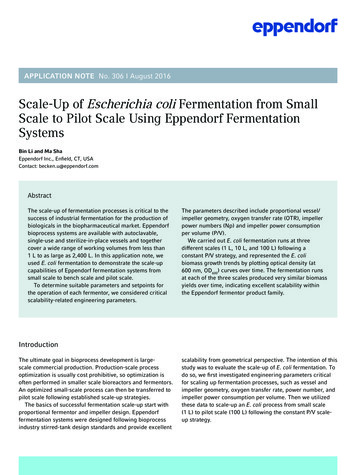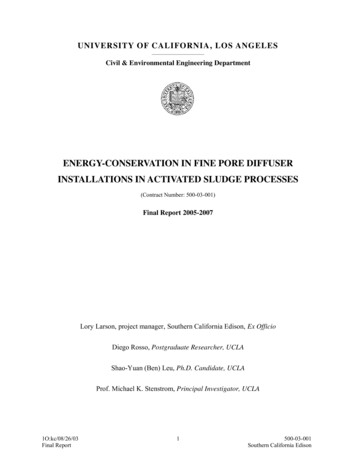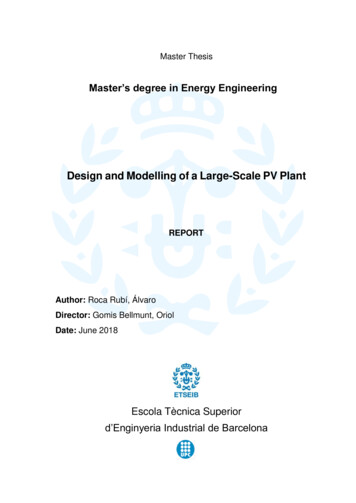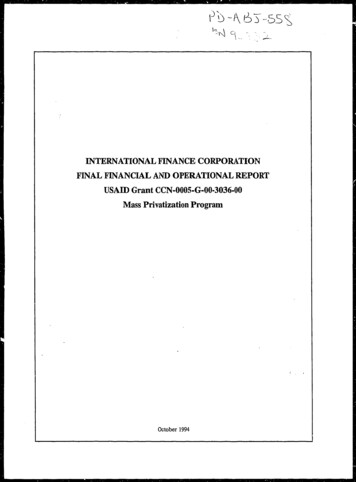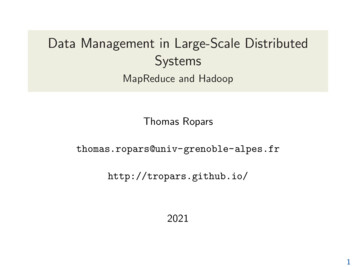
Transcription
Data Management in Large-Scale DistributedSystemsMapReduce and HadoopThomas ropars.github.io/20211
References Coursera – Big Data, University of California San Diego The lecture notes of V. Leroy Designing Data-Intensive Applications by Martin Kleppmann Mining of Massive Datasets by Leskovec et al.2
In this course History of MapReduce Overview of the Hadoop Eco-system Description of HDFS and Hadoop MapReduce Our first MapReduce programs3
AgendaIntroduction to MapReduceThe Hadoop Eco-SystemHDFSHadoop MapReduce4
MapReduce at GooglePublication The Google file system, S. Ghemawat et al. SOSP 2003. MapReduce: simplified data processing on large clusters, J.Dean and S. Ghemawat. OSDI 2004.Main ideas Data represented as key-value pairs Two main operations on data: Map and Reduce A distributed file systemI Compute where the data are located5
Use of MapReduce at Google Used to implement several tasks:IIIIBuilding the indexing system for Google SearchExtracting properties of web pagesGraph processingetc. Google does not use MapReduce anymore1I Moved on to more efficient technologies We will study BigTable (data storage) in this courseI The main principles are still -scale-analytics-system6
MapReduceThe Map operation Transformation operationI A function is applied to each element of the input set map(f )[x0 , ., xn ] [f (x0 ), ., f (xn )] map( 2)[2, 3, 6] [4, 6, 12]The Reduce operation Aggregation operation (fold) reduce(f )[x0 , ., xn ] [f ((x0 ), f ((x1 ), ., f (xn 1 , xn )))] reduce( )[2, 3, 6] (2 (3 6)) 11 In MapReduce, Reduce is applied to all the elements with thesame key7
Why MapReduce became very popular?Main advantages Simple to program Scales to large number of nodesI Targets scale out (share-nothing) infrastructures Handles failures automatically8
Simple to programProvides a distributed computing execution framework Simplifies parallelizationI Defines a programming modelI Handles distribution of the data and the computation Fault tolerantI Detects failuresI Automatically takes corrective actions Code once (expert), benefit to allLimits the operations that a user can run on data Inspired from functional programming (MapReduce) Allows expressing several algorithmsI But not all algorithms can be implemented in this way9
Scales to large number of nodesData parallelism Running the same task on different (distributed) data piecesin parallel. As opposed to Task parallelism that runs different tasks inparallel (e.g., in a pipeline)Move the computation instead of the data The distributed file system is central to the frameworkI GFS in the case of GoogleI Heavy use of partitioning The tasks are executed where the data are storedI Moving data is costly10
Fault toleranceMotivations Failures are the norm rather than the exception1 .I In Google datacenters, jobs can be preempted at any timeI MapReduce jobs have low priority and have high chances ofbeing preempted A 1-hour task has 5% chances of being preempted Dealing with stragglers (slow machines)1The Google file system, S. Ghemawat et al, 200311
Fault toleranceMechanisms Data are replicated in the distributed file system Results of computation are written to disk Failed tasks are re-executed on other nodes Tasks can be executed multiple times in parallel to deal withstragglersI Towards the end of a computation phase12
A first MapReduce programWord CountDescription Input: A set of lines including wordsI Pairs line number, line content I The initial keys are ignored in this example Output: A set of pairs word, nb of occurrences Input 1, ”aaa bb ccc” 2, ”aaa bb” Output ”aaa”, 2 ”bb”, 2 ”ccc”, 1 13
A first MapReduce programWord Countmap(key, value): /* pairs of {line num, content} */foreach word in value.split():emit(word, 1)reduce(key, values): /* {word, list nb occurences} */result 0for value in values:result valueemit(key, result) /* - {word, nb occurences} */14
A first MapReduce programWord Count1, ”aaa bb ccc”2, ”bb bb d”3, ”d aaa bb”4, ”d”map”aaa”, 1”bb”, 1”ccc”, 1”bb”, 1”bb”, 1”d”, 1”d”, 1”aaa”, 1”bb”, 1”d”, 1reduce”aaa”, 2”bb”, 4”ccc”, 1”d”, 315
A first MapReduce programWord Count1, ”aaa bb ccc”2, ”bb bb d”3, ”d aaa bb”4, ”d”map”aaa”, 1”bb”, 1”ccc”, 1”bb”, 1”bb”, 1”d”, 1”d”, 1”aaa”, 1”bb”, 1”d”, 1reduce”aaa”, 2”bb”, 4”ccc”, 1”d”, 3Question:How is it implemented in a distributed environment? (staytuned)15
Example: Web indexDescriptionConstruct an index of the pages in which a word appears. Input: A set of web pagesI Pairs URL, content of the page Output: A set of pairs word, set of URLs 16
Example: Web indexmap(key, value): /* pairs of {URL, page content} */foreach word in value.parse():emit(word, key)reduce(key, values): /* {word, URLs} */list []for value in values:list.add(value)emit(key, list) /* {word, list of URLs} */17
About batch and stream processingBatch processing A batch processing system takes a large amount of input data,runs a job to process it, and produces some output data. Offline systemI All inputs are already available when the computation starts In this lecture, we are discussing batch processing.Stream processing A stream processing system processes data shortly after theyhave been received Near real-time system The amount of data to process is unboundedI Data arrives gradually over time18
AgendaIntroduction to MapReduceThe Hadoop Eco-SystemHDFSHadoop MapReduce19
Apache Hadoop20
HistoryOpen source implementation of a MapReduce framework Implemented by people working at Yahoo! Inspired from the publications of Google Released in 2006Evolution A full ecosystem Used by many companiesI Facebook Big Data stack is still inspired by (and even makinguse of) cebook-accelerates-sql-at-extreme-scale/21
Hadoop evolution22
The Hadoop ecosystemThe main blocks HDFS: The distributed file system Yarn: The cluster resource manager MapReduce: The processing engine23
The Hadoop ecosystemThe main blocks HDFS: The distributed file system Yarn: The cluster resource manager MapReduce: The processing engineOther blocks Hive: Provide SQL-like query language Pig: High-level language to create MapReduce applicationsI Notion of Pipeline Giraph: Graph processing etc.23
A few words about YarnA resource management framework Dynamically allocates the resources of a cluster to jobs Allows multiple engines to run in parallel on the clusterI Not all jobs have to be MapReduce jobsI Increases resource usage Main components of the systemI ResourceManager: Allocates resources to applications andmonitors the available nodesI ApplicationMaster: Negotiates resources access for oneapplication with the RM; Coordinates the application’s tasksexecutionI The NodeManager: Launches tasks on nodes and monitorsresource usage Has been replaced by other frameworks (Mesos, Kubernetes)24
AgendaIntroduction to MapReduceThe Hadoop Eco-SystemHDFSHadoop MapReduce25
Hadoop Distributed File SystemPurposeStore and provide access to large datasets in a share-nothinginfrastructureChallenges Scalability Fault 9227316/hadoop-turns-1026
Hadoop Distributed File SystemPurposeStore and provide access to large datasets in a share-nothinginfrastructureChallenges Scalability Fault toleranceExample of large scale deployment At Yahoo!: 600PB of data on 35K 227316/hadoop-turns-1026
Target infrastructure (recall)Cluster of commodity machinesSwitch: storage: memory: processor27
Main principlesAchieving scalability and fault toleranceMain assumptions Storing large datasetsI Provide large aggregated bandwidthI Allow storing large amount of files (millions) Batch processing (i.e., simple access patterns)I The file system is not POSIX-compliantI Assumes sequential read and writes (no random accesses) Write-once-read-many file accesses Supported write operations: Append and Truncate Stream reading Optimized for throughput (not latency)28
Random vs Sequen)al disk access Example– DB 100M users– 100B/user– Alter 1% records Random access– Seek, read, write: 30mS– 1M users à 8h20 Sequen)al access– Read ALL Write ALL– 2x 10GB @ 100MB/S à 3 minutesà It is o‚en faster to read all and write all sequen)ally48
Main principlesAchieving scalability and fault tolerance29
Main principlesAchieving scalability and fault tolerancePartitioning Files are partitioned into blocks Blocks are distributed over the nodes of the system Default block size in recent versions: 128MBReplication Multiple replicas of each block are created Replication is topology aware (rack awareness) Default replication degree is 329
A Master-Slave architectureA set of DataNodes One daemon per node in the system A network service allowing to access the file blocks stored onthat nodeI It is responsible for serving read and write requestsOne NameNode Keeps track of where blocks are stored Monitors the DataNodes Entry point for clients30
HDFS DNDNDN: NameNode: DataNode31
Writing a filefor each cketsDNDNDNDNpetsackDNDNDNDNDNDNDNDN32
Writing a filefor each cketsDNDNDNDNpetsackDNDNDNDNDNDNDNDN32
Writing a filefor each cketsDNDNDNDNpetsackDNDNDNDNDNDNDNDN32
Writing a filefor each cketsDNDNDNDNpetsackDNDNDNDNDNDNDNDN32
Writing a filefor each cketsDNDNDNDNpetsackDNDNDNDNDNDNDNDN32
Writing a filefor each cketsDNDNDNDNpetsackDNDNDNDNDNDNDNDN32
Writing a filefor each cketsDNDNDNDNpetsackDNDNDNDNDNDNDNDN32
Writing a filefor each cketsDNDNDNDNpetsackDNDNDNDNDNDNDNDN32
Writing a file: Summary1. The client contacts the NameNode to request new filecreationI The NameNode makes all required checks (Permissions, filedoes not exists, etc.)2. The NameNode allows the client to write the file3. The client splits the data to be written into blocksI For each block, it asks the NameNode for a list of destinationnodesI The returned list is sorted in increasing distance from the client4. Each block is written in a pipelineI The client picks the closest node to write the blockI The DataNode receives the packets (portions) and forwardsthem to the next DataNode in the list5. Once all blocks have been created with a sufficient replicationdegree, the client acknowledges file creation completion to thename node.6. The NameNode flushes information about the file to disk33
Reading a filefor each blockB1R: eNada ,FNB2 B2 ?iBlbe2, ANc;.;SwitchB1B1 ?ClientDNDNNNDNDNDNDNDNDNDNDNDNDNDNDNDNDNDNDN34
Reading a filefor each blockB1R: eNada ,FNB2 B2 ?iBlbe2, ANc;.;SwitchB1B1 ?ClientDNDNNNDNDNDNDNDNDNDNDNDNDNDNDNDNDNDNDN34
Reading a filefor each blockB1R: eNada ,FNB2 B2 ?iBlbe2, ANc;.;SwitchB1B1 ?ClientDNDNNNDNDNDNDNDNDNDNDNDNDNDNDNDNDNDNDN34
Reading a filefor each blockB1R: eNada ,FNB2 B2 ?iBlbe2, ANc;.;SwitchB1B1 ?ClientDNDNNNDNDNDNDNDNDNDNDNDNDNDNDNDNDNDNDN34
Reading a filefor each blockB1R: eNada ,FNB2 B2 ?iBlbe2, ANc;.;SwitchB1B1 ?ClientDNDNNNDNDNDNDNDNDNDNDNDNDNDNDNDNDNDNDN34
Reading a filefor each blockB1R: eNada ,FNB2 B2 ?iBlbe2, ANc;.;SwitchB1B1 ?ClientDNDNNNDNDNDNDNDNDNDNDNDNDNDNDNDNDNDNDN34
Reading a file: Summary1. The client contacts the NameNode to have info about a file2. The NameNode returns the list of all blocksI For each block, it provides a list of nodes hosting the blockI The list is sorted according to the distance from the client3. The client can start reading the blocks sequentially in orderI By default, contacts the closest DataNodeI If the node is down, contacts the next one in the list35
Supported file formats Text/CSV files JSON records Sequence files (binary key-value pairs)I Can be used to store photos, videos, etc Defining custom formatsI AvroI ParquetI ORC36
AgendaIntroduction to MapReduceThe Hadoop Eco-SystemHDFSHadoop MapReduce37
In a NutshellA distributed MapReduce framework Map and Reduce tasks are distributed over the nodes of thesystem Runs on top of HDFSI Move the computation instead of the data Fault tolerant2 main primitives Map (transformation) Reduce (aggregation)38
In a nutshellKey/Value pairs MapReduce manipulate sets of Key/Value pairs Keys and values can be of any typesFunctions to apply The user defines the functions to apply In Map, the function is applied independently to each pair In Reduce, the function is applied to all values with the samekey39
MapReduce operationsAbout the Map operation A given input pair may map to zero, one, or many output pairs Output pairs need not be of the same type as input pairsAbout the Reduce operation Applies operation to all pairs with the same key 3 steps:I Shuffle and Sort: Groups and merges the output of mappers bykeyI Reduce: Applies the reduce operation to the new key/valuepairs40
Distributed executionFigure ntroduction-to-the-mapreduce-life-cycle41
Distributed execution: the detailsMap tasks As many as the number of blocks to process Executed on a node hosting a block (when possible) Data read from HDFSReduce tasks Number selected by the programmer Key-value pairs are distributed over the reducers using a hashof the key The output is stored in HDFS42
Data managementMoving data from the Map to the Reduce tasks1. Output of map tasks are partitioned. The result is storedlocallyI As many partitions are created as the number of reducersI By default, a partitioning function based on the hash of thekey is usedI The user can specify its own partitioning function2. The reducers fetch the data from the map tasksI They connect to the map nodes to fetch data (shuffle)I This can start as soon as some map tasks finish (customizable)3. The reducers sort the data by key (sort)I Can start only when all map tasks are finished43
Reducing the amount of data transferredCombiner User-defined function for local aggregation on the map tasks Applied after the partitioning functionnode Bnode Bnode B1, ”bb bb””bb”, 1”bb”, 3”bb”, 1”bb”, 1combeucredmapnode Anode Anode A1, ”aa bb””aa”, 1”aa”, 32, ”aa aa”map”bb”, 1”aa”, 1comb”bb”, 1node C”aa”, 3”bb”, 4reduce2, ”bb””aa”, 144
About more complex programsWorkflowsSequence of Map and Reduce operations The output of one job is the input of the next job Example: Getting the word that occurs to most often in a textI Job 1: counting the number of occurrence of each wordI Job 2: Find the word with the highest countImplementation No specific support in Hadoop Data simply go through HDFS45
Additional referencesMandatory reading MapReduce: Simplified Data Processing on Large Clusters, byJ. Dean and S. Ghemawat.Suggested reading Chapter 10 of Designing Data-Intensive Applications byMartin Kleppmann HDFS Carton: Hdfs-cartoon.pdf MapReduce illustration: e46
Description of HDFS and Hadoop MapReduce Our rst MapReduce programs 3. Agenda Introduction to MapReduce The Hadoop Eco-System HDFS Hadoop MapReduce 4. MapReduce at Google . A Master-Slave architecture A set of DataNodes One daemon per node in the system A network service allowing to access the le blocks stored on

